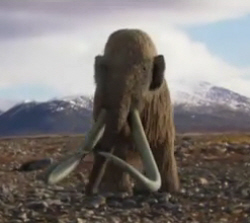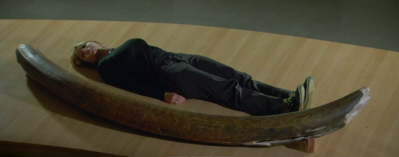Woolly Mammoth
Mammuthus primigenius
Woolly Mammoth – Secrets From The Ice – by Professor Alice Roberts.
Imagine an elephant, but with tasks at least twice the size of those borne by an elephant living today. Imagine an elephant, but covered in a thick shaggy coat of hair, some of those hairs over a metre in length. Imagine an elephant which lived not in the warmth of the tropics, but in the ice and snow of the North. The woolly mammoth.
These majestic titans ruled Europe and Asia long before our own ancestors fell under their spell. Extinct for thousands of years they are iconic, yet mysterious. Climate change means that the frozen North is melting faster than ever before. Prehistoric carcasses are emerging and, from them, we can unlock the secrets of these long-lost beasts. Using the latest technology, we can now answer questions about the mammoth which have a long-puzzled scientists.
We are able to trace the evolution, revealing their adaptations to one of the harshest places on the planet. And with every new find, we take a step closer to answering the biggest question of all – why did these magnificent animals suddenly go extinct?

Woolly Mammoth
Siberia; here, the temperature hovers around -40° for months on end. Few animals can survive here. A hundred thousand years ago, it was a different
story. This giant swathe of Eurasia was home to vast herds of woolly mammoths. Perfectly adapted to the extremes of the Arctic, a tiny population
survived on a remote island until about 4000 years ago. But, on mainland Siberia, they mysteriously died out at the end of the last Ice Age.
But, we’re left with a treasure trove of their remains, locked in Siberia’s layer of frozen ground, the permafrost.
As global warming raises the Earth’s temperature, melting the permafrost faster than ever, the secrets of the mammoth are finally emerging. After centuries of collecting their remains, we can paint a detailed picture of these long-lost beasts far better than we can for any other extinct species.

Mammoth Tusk
We know that they lived for up to 60 years and were perfectly built for life in the freezer. But many of their adaptations have remained secret, until now. And there is one big question, which remains unanswered. What killed them off?
Lyuba – Baby Mammoth Remains
This is one of the most famous mammoth-finds of recent years. She’s called Lyuba, and she’s a little baby mammoth, probably just a month old.
She was found in 2007 and she is amazingly well preserved, so that we have her skin, her soft tissues and we even have the contents of her gut.
Lyuba has been radiocarbon dated to 37,000 years old. Found in the far north-west of Siberia, Lyuba is considered to be the best-preserved
mammoth ever discovered.
Professor Roberts muses “It’s wonderful to get so close to this little baby mammoth and see how beautifully preserved she is. You can see the
texture of the skin, you can see individual hair follicles there, and there’s even some fur preserved, some little patches of it. And then on the
surface of the skin as well, there are these peculiar blue discs.”
Trunk Tip Shape
As members of the elephant family, it is believed that mammoths would have behaved in a very similar way to their modern relatives.
They’d have lived in extended social groups, the females of all ages, young males and infants. Now, remains from the Siberian permafrost are
revealing far more than just teeth and bones ever could.
The frozen baby Lyuba shows that mammoths possessed an unusual tool, perfect for feeding on this steppe. She’s got this very particular shape to
the end of her trunk, which is quite different from modern-day elephants, and is designed to be able to delicately pull up little tufts of a
newly-sprouted grass and shrubs.
Because Lyuba is so well-preserved, new scientific techniques have enabled us to examine her internal organs, revealing startling adaptations
to the extremes of the ice age. Recent CT scans show her kidneys are far larger than you’d expect for an animal of her size. This type of
oversized kidney is also seen in desert-adapted camels suggesting that mammoths internal structure was also changing to cope with the dry
conditions of the mammoth steppe, where there was plenty of food, but little water.
Bernard Buigues
Frozen carcasses like Lyuba are revered by scientists as a windows into the past. She was found on the banks of the Uribei river, on
Siberia’s Yamal peninsula. She was brought in from the cold by the French explorer Bernard Buigues. He’s hunted mammoth remains for over 20 years,
amassing a huge collection which he shares with scientists around the world.
Bernard works closely with a large network of indigenous Arctic people. They contact him when they stumble upon mammoth remains. He now
gets more calls than ever as the permafrost is melting at an unprecedented rate, exposing potential new finds.
Bernard is a member of the International Mammoth Committee, a team which includes palaeontologists, geophysicists with ground-penetrating
radar and even an ex-KGB officer.
Prof. Dan Fisher
Prof Dan Fisher of Michigan University is the world’s leading mammoth tusk expert. He visits the Arctic each year, and, through
analysing hundreds of tusks, has developed an unrivalled understanding of the mammoth populations that once roamed here. Tusks, not
unlike trees, contain growth rings which can reveal a great deal about the animal.
The tusks of an elephant and their relatives are teeth, modified second incisors.
The largest mammoth tusks ever found weighed almost 120 kg each. Both male and female mammoths possessed large tusks, and it
seems that the weight of carrying such huge objects required them to have larger neck and shoulder muscles than we see in modern elephants.
Mammoth Herd
Drilling out tiny amounts of ivory from the daily growth lines allows Dan’s team to analyse chemical isotopes laid down on that day,
painting a prehistoric picture of the animal’s life with a level of detail that is not possible for any other extinct species. Oxygen
isotopes from the water it drank, reveal where the mammoth roamed throughout it’s life. Nitrogen isotopes reveal where a mammoth
was getting its protein from. We can even pinpoint exactly when an infant was weaned from its mother’s milk. Carbon
isotopes show the types and relative quantities of plants eaten.
Because the growth lines are so detailed, Dan can identify the point when, upon reaching sexual maturity, teenage male mammoths
were cast out from the herds and left to find food for themselves.
It’s also possible to see that sexually mature males starve themselves every year, during the period known as must, just as
living elephants do.
Mammoth Thigh Bone showing intact Marrow
In far Eastern Siberia an incredible new discovery is being heralded as the holy grail of mammoth science. In the city of
Yakutsk, members of the International Mammoth Committee have unearthed a completely intact frozen mammoth thigh bone.
Although thousands of years old, it’s one of the best preserved bone specimens retrieved from the permafrost. So perfectly
frozen that it contains pure mammoth bone marrow. This could be the best source ever of fully intact mammoth cells, with
undamaged DNA.
The marrow will be sent to a lab in Japan where they will try to extract intact cell nuclei, and insert them into a host elephant
egg. If successful, scientists there predict that they will be able to clone a mammoth by using a female elephant as a surrogate
mother within five years.


